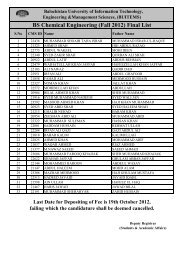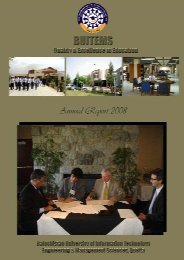BUITEMS
Research Journal - buitems
Research Journal - buitems
- No tags were found...
Create successful ePaper yourself
Turn your PDF publications into a flip-book with our unique Google optimized e-Paper software.
<strong>BUITEMS</strong><br />
Quality & Excellence in Education<br />
Introducing Lane Based Sectoring for Routing in VANETs<br />
Faisal Khan 1 , Yusun Chang 1 , SungJin Park 1 , Ehsanullah Kakar 2 , John Copeland 1<br />
1<br />
School of Electrical and Computer Engineering, Georgia Institute of Technology, Atlanta, USA<br />
2<br />
Department of Civil Engineering Balochistan University of Information Technology Engineering &<br />
Management Sciences, Quetta.<br />
Abstract<br />
Vehicular Ad hoc Networks (VANET s) provide vehicle-to-vehicle and vehicle-to-infrastructure<br />
communication using Dedicated Short-Range Communications (DSRC). The core objective<br />
of VANET s is to provide safety message communication among vehicles. In dense<br />
urban traffic, safety message com munication encounters severe packet collisions<br />
due to excessive number of nodes contending to access the control channel. In<br />
such a complex dense and mobile scenario, an ideal single vehicle per time slot<br />
has yet not been achieved. This paper introduces the use of lane level location<br />
information to achieve a single vehicle per time slot configuration. The transmission<br />
range of a message originator is divided into a grid using distance and lanes as<br />
the two variables. Each block within the grid houses a single vehicle at most that<br />
is assigned a unique time slot. The contention among nodes for the same time<br />
slot is virtually removed. Theory and ns-3 simulation justify the feasibility, and prove<br />
that the technique reduces packet collisions by 2%, and improves message dissemination<br />
speed by as much as 30% each hop.<br />
Keywords:- VANETs, Road-width, Lanes, Sectoring<br />
* Corresponding Author’s email: ehsan@buitms.edu.pk<br />
INTRODUCTION<br />
With the exponential increase of vehicles on<br />
the road, driving has become increasingly<br />
difficult and risky. In order to ensure passenger<br />
safety in challenging road scenarios, car<br />
manufacturers together with government<br />
agencies are in pursuit of a solution called<br />
Vehicular Ad hoc Networks (VANETs).<br />
VANETs would allow drivers to anticipate hazardous<br />
traffic events and approaching bad traffic<br />
conditions through inter-vehicle communication.<br />
One of the critical de- sign issues in VANETs is<br />
the dissemination of safety messages beyond the<br />
immediate transmission range of a vehicle. The<br />
propagation requires multi-hop forwarding of the<br />
message by selected vehicles among a large<br />
number of contenders. The problem becomes<br />
severe in dense urban traffic where higher<br />
number of contending vehicles results in<br />
excessive packet collisions. Since these collisions<br />
greatly impact reliability of reception and overall<br />
message dissemination speed, it remains the core<br />
concern while developing ideas for message<br />
routing in VANETs (Yan et al., 2010).<br />
Considerable work has been carried to address<br />
the safety message propagation problem in<br />
VANETs. One common approach used to<br />
provide multi-hop forwarding is to divide the<br />
transmission range of message originating<br />
vehicle into multiple geographical sectors based<br />
on distance (Korkmaz et al., 2004, Fasolo et al.,<br />
2006, Khan et al., 2011) Vehicles in each sector<br />
pick a random backoff value from a contention<br />
window assigned to that sector. Contention<br />
windows are assigned in such a way that<br />
vehicles in the furthest sector can transmit first.<br />
Forwarding task is assigned to vehicle with<br />
minimum backoff. Since contention within a<br />
sector is random, it is highly probable in<br />
dense traffic environments that two vehicles<br />
within the same sector pick the same backoff<br />
value, thus causing collision. Further narrowing<br />
the sector length may minimize the effect to a<br />
certain degree. However, even with minimum<br />
possible sector length—equal to the length of a<br />
79
















